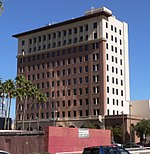J. C. Penney–Chicago Store Building
Buildings and structures in Tucson, ArizonaCommercial buildings on the National Register of Historic Places in ArizonaDepartment stores on the National Register of Historic PlacesEconomy of Tucson, ArizonaJCPenney ... and 3 more
National Register of Historic Places in Tucson, ArizonaPages with login required references or sourcesRetail buildings in Arizona

The J. C. Penney–Chicago Store is a historic department store building in downtown Tucson, Arizona. Built in 1903 for the Los Angeles Furniture Co, it housed J. C. Penney by July 25, 1942. In 1957, after J. C. Penney moved to the west side of Stone Avenue just north of Pennington Street, Aaronson Brothers moved in. The Chicago Store moved in after the El Paso–based department store closed in 1967. This building had the last complete original vintage interior in Downtown Tucson with stamped tin ceilings and period woodwork until it was completely gutted in 2020-2022.
Excerpt from the Wikipedia article J. C. Penney–Chicago Store Building (License: CC BY-SA 3.0, Authors, Images).J. C. Penney–Chicago Store Building
East Congress Street, Tucson
Geographical coordinates (GPS) Address Nearby Places Show on map
Geographical coordinates (GPS)
| Latitude | Longitude |
|---|---|
| N 32.2217 ° | E -110.9689 ° |
Address
East Congress Street 130
85701 Tucson
Arizona, United States
Open on Google Maps











